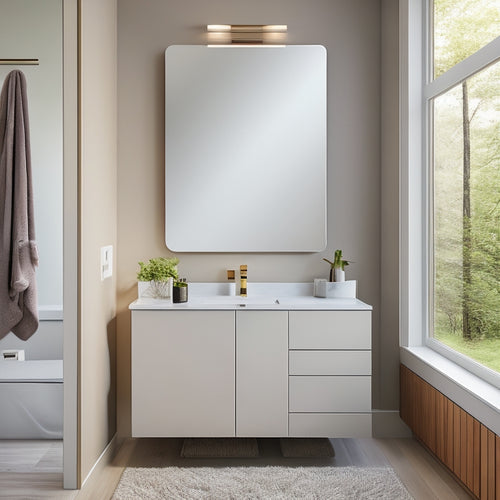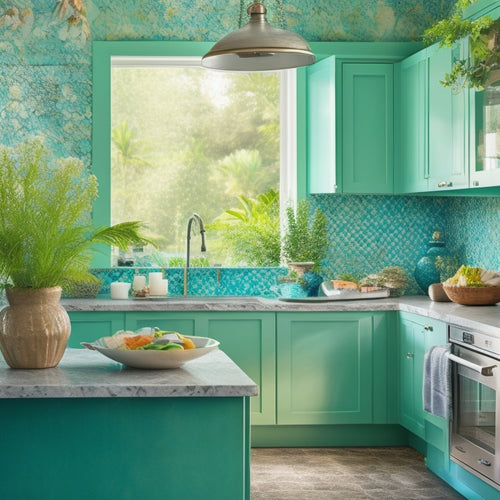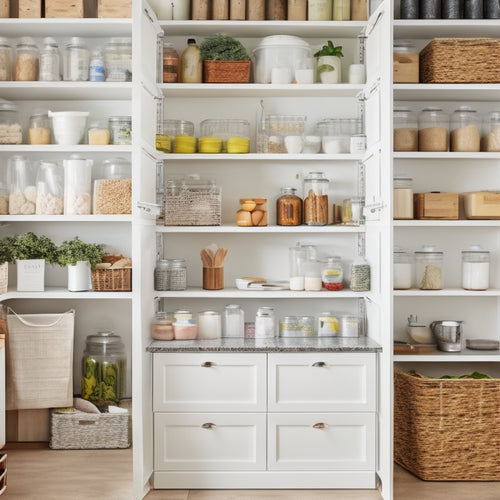
What Makes a Great Mounted Cabinet Design?
Share
You begin by understanding that a great mounted cabinet design is one that expertly balances aesthetics, functionality, and durability, ultimately creating a seamless integration with your living space and personal style. You'll want to take into account ergonomic principles, user experience, and size and shape to guarantee comfort and accessibility. Material selection and finish are vital for durability and aesthetics, while space optimization strategies and customization options help maximize storage capacity. By prioritizing functionality, you'll create a beautiful and practical design that serves your needs. As you investigate these essential elements, you'll uncover the secrets to designing a mounted cabinet that perfectly complements your space and style.
Key Takeaways
- A great mounted cabinet design balances functionality and aesthetics, ensuring a harmonious visual experience that complements the surrounding decor.
- Effective space optimization strategies, such as vertical storage and adjustable shelves, maximize interior storage capacity without consuming floor space.
- Durable materials and finishes, like reclaimed wood and low-VOC paints, ensure the cabinet withstands daily use and environmental factors while promoting sustainability.
- A well-designed cabinet prioritizes ergonomic accessibility, with features like easy reach and convenient item retrieval, to enhance user experience and comfort.
- Customization and flexibility, achieved through modular component options and adaptive design elements, allow the cabinet to adapt to changing storage needs and preferences.
Key Elements of Design
When approaching a mounted cabinet design, several key elements come into play to guarantee a functional and aesthetically pleasing outcome.
You'll want to take into account the ergonomic design principles that make certain the cabinet is accessible and comfortable for users. Think about the user experience - how will they interact with the cabinet, and what features will make it easy for them to find what they need?
You'll need to balance the cabinet's size and shape with the available wall space, assuring a snug fit that doesn't overwhelm the surrounding area.
The cabinet's material and finish will also impact its overall look and durability. Reflect on the color scheme and style of the surrounding area, and choose materials that blend in or provide a stylish contrast.
Space Optimization Strategies
Having balanced the cabinet's size and shape with the available wall space, you now need to optimize the interior space to maximize storage capacity and ease of access. This is where space optimization strategies come into play.
By utilizing vertical storage, you can make the most of the cabinet's interior, packing in more items without taking up too much floor space. Consider installing shelves, baskets, or compartments that can be stacked to maximize space efficiency.
A well-designed cabinet should have adjustable shelves and compartments that can be customized to fit your specific storage needs. Additionally, consider the "dead space" between shelves and walls – can you squeeze in a narrow shelf or basket to store small items like screws or beads?
Think vertically, but also think cleverly. Every inch counts when it comes to maximizing storage capacity. By implementing these strategies, you'll be able to store more, stress less, and enjoy a more organized, clutter-free space.
Material Selection Importance
As you move forward with your mounted cabinet design, the materials you select will substantially impact the cabinet's durability, functionality, and overall aesthetic.
You'll want to choose materials that can withstand the wear and tear of daily use, while also fitting your desired color scheme and style.
Material durability is essential, especially if you're planning to install the cabinet in a high-traffic area or a humid environment.
Look for materials with moisture-resistant coatings or water-repellent finishes to guarantee your cabinet remains sturdy and functional.
When it comes to color selection, consider the room's ambiance and the cabinet's intended purpose.
For instance, a bold color might be perfect for a statement piece in a modern living room, while a more subdued tone might be better suited for a minimalist kitchen.
Don't be afraid to get creative, but remember to balance your personal style with the cabinet's functional requirements.
Aesthetic Appeal Considerations
You've selected the perfect materials for your mounted cabinet design, guaranteeing durability and functionality.
Now, it's time to think about aesthetics. After all, you want your cabinet to be a visual masterpiece, not an eyesore.
Aesthetic appeal is all about creating a harmonious visual experience. You can achieve this by selecting a color scheme that connects with your personal style or blends seamlessly with the surrounding decor.
Don't be afraid to get creative – bold contrasts or subtle distinctions can make your cabinet stand out.
Visual balance is also essential. Consider the size, shape, and orientation of your cabinet to confirm it doesn't overwhelm the space.
Symmetry, asymmetry, or a mix of both – the key is to create a sense of harmony.
Remember, your mounted cabinet design should be a statement piece, not a design disaster.
Functionality and Purpose
Beyond aesthetics, your mounted cabinet design must serve a purpose, fulfilling specific functional needs within the space. You shouldn't just slap together some shelves and call it a day.
Think about how you'll use the cabinet and what you need to store. Will you be accessing items frequently, or will they be stored long-term? This determines the type of storage you need, such as drawers, shelves, or cabinets with doors.
Ergonomic design is essential for user accessibility. You don't want to strain your back or shoulders reaching for items. Consider the "golden zone" – the area between your shoulders and hips – where you can easily access items without strain.
Design your cabinet with this in mind, placing frequently used items at waist level and less-used items above or below.
Functionality also means thinking about the flow of your space. Will the cabinet be near a workstation or a high-traffic area?
Make sure the design doesn't obstruct walkways or create bottlenecks. By prioritizing functionality and purpose, you'll create a mounted cabinet design that's both beautiful and practical.
Size and Proportion Matters
Most mounted cabinets are designed to hold a specific amount of weight, so it's crucial to determine the ideal size and proportion for your storage needs. You don't want a cabinet that's too small to hold everything, but you also don't want one that's so large it's cumbersome and overwhelming.
Here's what you should consider when determining the perfect scale and balance for your mounted cabinet:
-
Scale: Confirm the cabinet is proportional to the surrounding area. A large cabinet in a small space can make the area look cluttered and cramped.
-
Visual Harmony: Verify the cabinet's design and style blend with the surrounding decor. A modern cabinet in a traditional setting can be jarring and unpleasant to the eye.
-
Space Constraints: Consider the space available for the cabinet, including any obstacles like pipes or electrical outlets.
-
Weight Capacity: Calculate the total weight of the items you plan to store and verify the cabinet can handle it.
-
Aesthetics: Think about the overall look and feel you want to achieve. A well-designed cabinet can enhance the entire space, while a poorly designed one can detract from it.
Customization and Flexibility
You're not limited to a one-size-fits-all solution with mounted cabinet design.
By incorporating personalized space planning, you can optimize your cabinet's layout to suit your specific needs.
With adaptive design elements and modular component options, you can create a customized storage system that adjusts to your changing requirements.
Personalized Space Planning
Three key aspects of mounted cabinet design come together to create a truly personalized space planning experience: configurability, modularity, and adaptability. This trifecta allows you to tailor your mounted cabinet to fit your unique user preferences and lifestyle.
You're not forced into a one-size-fits-all solution; instead, you can customize the design to accommodate your specific needs.
Some benefits of personalized space planning include:
-
Maximum efficiency: By designing your mounted cabinet around your workflow, you can reduce clutter and increase productivity.
-
Increased storage: With the ability to customize the layout, you can maximize storage capacity and keep frequently used items within easy reach.
-
Improved accessibility: Adapt the design to accommodate your physical needs, ensuring that everything is easily accessible and comfortable to use.
-
Enhanced aesthetics: Personalized space planning allows you to incorporate your personal style into the design, creating a visually appealing space that reflects your personality.
-
Future-proofing: With a modular design, you can easily reconfigure your mounted cabinet as your needs change, ensuring it remains functional and effective for years to come.
Adaptive Design Elements
Each mounted cabinet design incorporates a range of adaptive design elements that allow for seamless customization and flexibility. You're not stuck with a one-size-fits-all solution; instead, you get a customized fit that adapts to your unique needs. This is where the magic happens – where you can mix and match components to create a space that's truly yours.
These adaptive design elements let you choose from a palette of sustainable materials, ensuring your mounted cabinet not only looks great but also does its part for the planet. You might opt for recycled glass shelves or FSC-certified wood, knowing you're making an eco-friendly choice.
Innovative storage solutions also come into play, allowing you to maximize your space without sacrificing style. Think adjustable shelves, soft-close drawers, and clever accessories that keep your belongings organized and within reach.
With adaptive design elements, the possibilities are endless, and your mounted cabinet becomes a reflection of your personal style and priorities.
Modular Component Options
The adaptive design elements of your mounted cabinet design now give way to modular component options, which further amplify customization and flexibility.
This is where the magic happens, and you get to tailor your cabinet to your specific needs. Modular component options allow you to mix and match different parts to create a unique configuration that suits your style.
With modular shelving, you can:
- Add or remove shelves as needed
- Swap out drawer sizes to accommodate different items
- Incorporate interchangeable components, like baskets or bins, for added storage
- Adjust the height and depth of your shelves to fit your space
- Incorporate specialized components, like a wine rack or utensil holder, to enhance functionality
Durability and Build Quality
When designing a mounted cabinet, you'll want to make certain it's built to last, and that's where durability and build quality come in.
You should expect strong materials to be used throughout the construction process, along with reinforced methods that assure a sturdy final product.
A rigorous finishing process will also provide an added layer of protection against wear and tear.
Strong Materials Used
One key aspect of a mounted cabinet's durability and build quality lies in its strong materials used.
You want a cabinet that can withstand the test of time, and that's where material selection comes in. A great mounted cabinet design incorporates materials that aren't only durable but also sustainable.
When it comes to strong materials, you should look for:
- Reclaimed wood: reduces waste and adds a touch of uniqueness to your cabinet
- Low-VOC paints: guarantees better indoor air quality and a healthier environment
- Recyclable metals: reduces environmental impact and supports a circular economy
- Durable finishes: provides a long-lasting, scratch-resistant surface
- Sustainably sourced glass: reduces carbon footprint and adds an eco-friendly touch
Reinforced Construction Methods
You're looking for a mounted cabinet that's built to last, and strong materials are just the starting point.
Now, it's time to talk about the construction methods that make all the difference. Reinforced construction is key to ensuring your cabinet can withstand the weight of its contents and any external forces it may encounter.
Joint reinforcement is critical to maintaining the cabinet's structural integrity. This involves reinforcing the joints where the shelves and sides meet, making sure they can handle the load capacity. Think of it like a durable skeleton that holds everything together.
A great mounted cabinet design incorporates load capacity calculations to guarantee it can support the weight of its intended use. This includes considering factors like the weight of the shelves, fixtures, and contents, as well as any external forces like wind or vibrations.
With reinforced construction methods, you can trust your cabinet to withstand the test of time and remain sturdy for years to come.
Robust Finishing Process
A sturdy finishing process is the final vital step in crafting a mounted cabinet that exudes durability and exceptional build quality. You want a finish that's more than just a pretty face - it's got to be tough enough to withstand the rigors of daily use.
A strong finishing process involves more than just slapping on a coat of paint or varnish; it requires careful attention to detail and a comprehensive grasp of the materials involved.
Here are some key elements of a strong finishing process:
-
Advanced finishing techniques: From hand-sanding to precision spray coating, the right techniques can make all the difference in the world.
-
Surface treatments: Whether it's a durable polyurethane or a sleek powder coat, the right surface treatment can add an extra layer of protection and style to your cabinet.
-
Moisture-resistant materials: Because let's face it, moisture is the enemy of any mounted cabinet. Using materials that can withstand humidity and water exposure is essential.
-
Thorough quality control: A strong finishing process involves rigorous quality control measures to guarantee that every cabinet meets the highest standards.
-
Durable hardware and fittings: You don't want your beautiful cabinet to be let down by flimsy hardware or fittings. Choose components that are built to last.
Easy Installation Features
With mounted cabinets, the installation process is often a major concern, and that's why designers have incorporated easy installation features to simplify the task. You don't have to be a DIY expert to get it right! These features make a huge difference, and we're not just talking about saving time. Easy installation also reduces the risk of errors and damage to the cabinet or surrounding area. So, what makes a mounted cabinet design easy to install?
| Feature | Description |
|---|---|
| Adjustable mounting | Allows for easy adjustments during installation to guarantee a secure fit |
| Pre-drilled holes | Eliminates the need for drilling, making installation faster and more accurate |
| Color-coded connections | Simplifies electrical connections, reducing errors and safety risks |
| Modular design | Enables easy assembly and disassembly, making installation a breeze |
| User-friendly instructions | Guides you through the installation process with clear, step-by-step directions |
These features guarantee a user-friendly installation experience. By incorporating them into your mounted cabinet design, you'll have a cabinet that's not only functional but also easy to install.
Seamless Integration Options
Your mounted cabinet design seamlessly blends into its surroundings when it integrates effortlessly with existing fixtures and appliances. This harmonious union is made possible by clever design elements that prioritize seamless integration.
A well-designed mounted cabinet should be able to:
-
Incorporate hidden storage: cleverly concealed compartments and shelves that maximize storage without compromising the cabinet's clean lines.
-
Utilize innovative attachments: cleverly designed hooks, straps, and clamps that securely attach the cabinet to the wall, ensuring stability and minimizing visual impact.
-
Integrate with existing plumbing and electrical: cleverly routed pipes and wires that blend seamlessly with the surrounding infrastructure.
-
Complement adjacent design elements: harmoniously matching the cabinet's color, texture, and style with adjacent fixtures and appliances.
-
Incorporate adaptive technology: cleverly integrated sensors and smart home technology that seamlessly integrates with your daily routine.
Frequently Asked Questions
Can Mounted Cabinets Be Used in Both Residential and Commercial Spaces?
You'll be delighted to know that mounted cabinets are versatile space savers that can seamlessly fit into both residential and commercial spaces, offering aesthetic versatility to boot, whether you're a homeowner or a business owner!
How Do I Ensure Proper Ventilation Behind the Cabinet?
As you envision a cabinet that's as cool as a summer breeze, remember to leave breathing room: guarantee proper ventilation behind the cabinet by using clever ventilation techniques and choosing cabinet materials that don't suffocate airflow, like mesh or perforated metal.
Are All Mounted Cabinets Suitable for Load-Bearing Walls?
You'll need to evaluate the wall materials and mounting techniques when deciding if a mounted cabinet is suitable for a load-bearing wall - it's not a one-size-fits-all deal, so don't get screwed (literally!) by assuming it'll work without proper planning.
Can I Install a Mounted Cabinet Without Professional Help?
You can try a DIY installation, but you'll need to become proficient in mounting techniques, like anchoring and leveling, to guarantee stability. Don't risk a cabinet catastrophe; consider seeking help if you're not a handy hero.
Do Mounted Cabinets Require More Maintenance Than Floor-Standing Ones?
Like a proud parent, you're wondering if mounted cabinets are high-maintenance divas. The answer is, it depends on the materials you choose. With regular dusting and occasional deep cleaning, your mounted cabinet's maintenance frequency will be as smooth as a well-oiled machine.
Conclusion
You've carefully balanced form and function, optimized every inch, and selected materials that exude quality. Your mounted cabinet design is a concerto of aesthetic appeal, customization, and durability. It's a seamless fusion of purpose and precision, where every element works in harmony to enhance your space. With easy installation and integration, your design becomes a work of art of both style and substance, a true reflection of your vision and creativity. It's a space that inspires, a space that thrives.
Related Posts
-

Innovative Hidden Storage for Modern Bathrooms
You're investing in a modern bathroom that's a serene oasis, and ample hidden storage is essential to maintaining tha...
-

Aqua-Themed Kitchen Delights: Unique and Functional Finds
Aqua-themed kitchens effortlessly blend style and serenity, creating a haven for cooking and entertaining. To bring t...
-

Get Organized: Free Pantry Labels + More
I've learned the hard way that organization comes before labeling - a cluttered pantry with labels can actually look ...


